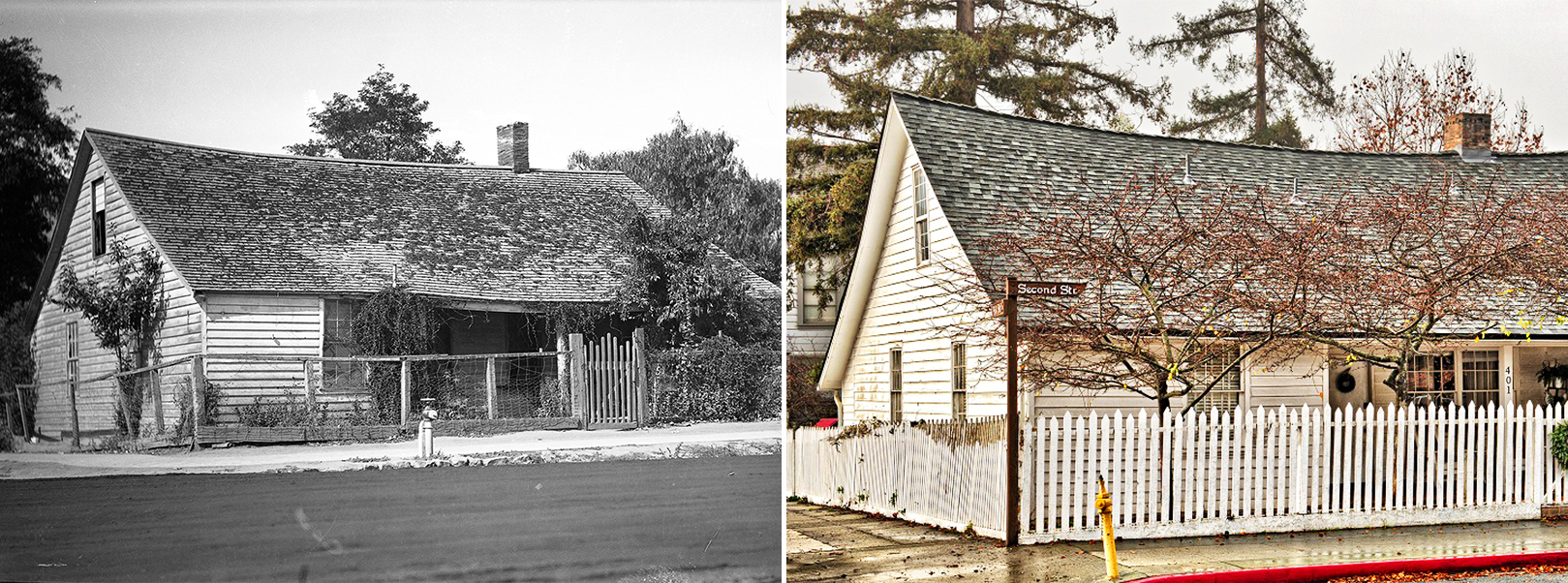Crane House/ Oxcart Tavern
San Juan’s first wood frame structure was originally a trading post site and location of the Oxcart Tavern. While appearing to be Cape Cod style, this one and a half story wood-framed building with shiplap siding is actually a consolidation under one larger roof the several additions to what was originally the Oxcart Tavern. It was the work of John Miller and Israel Mylar in 1857 to adapt the building into a residence.
 The Oxcart Tavern was built by Don José Maria Sánchez and may have been operated by Thomas Doak, a Boston sailor and painter of the reredos in the San Juan Mission who was among the first American settlers during the Spanish era of California. Alterations were done to the building in 1857, 1939, in the 1950s and again in the 1990s. The house remained in the same family (descendants of Don José Maria Sánchez) from 1857-1996.
The Oxcart Tavern was built by Don José Maria Sánchez and may have been operated by Thomas Doak, a Boston sailor and painter of the reredos in the San Juan Mission who was among the first American settlers during the Spanish era of California. Alterations were done to the building in 1857, 1939, in the 1950s and again in the 1990s. The house remained in the same family (descendants of Don José Maria Sánchez) from 1857-1996.
Maria Encarnacion Ortega Sanchez arrived in 1857 and lived in the house until her death in 1894. She was the great granddaughter of Jose Francisco Ortega who brought the first Spanish settlers to California in 1774 with the Portola Expedition. Her uncle was John Gilroy for whom the town of Gilroy is named. She had 5 husbands, all of whom died tragically. After the death of her first husband, Don José Maria Sánchez, who drowned at the place called the Malpaso (the bad step) in the Pajaro River on Christmas Eve 1852, she was left with their five children and an estate worth over $300,000, thus becoming the wealthiest woman in California.
She chose to live in the house because of its proximity to the convent school that her daughters attended, and for its convenience of walking to mass at the Mission. After the death of her third husband, she married attorney George Crane who had come to California to join Fremont’s regiment as an intelligence agent under the guise of supply officer. He later became a Judge. Maria deeded her inherited land to George Crane who spent the Sanchez fortune on gambling, lavish entertaining and a run for state senate. His died in 1868 from small pox he contracted while helping victims of the disease plagued many of San Juan’s citizens that year. Judge Crane along with other historic figures was noted for helping create the first framework for California’s state legislature.
The original structure was built with adobe used between the bricks instead of grout and horse hairs used in the concrete between the boards to act as a fiber holding the walls together. Originally the house had no foundation and was set right on the ground. Animal blood was mixed into the dirt to create a hard floor. Hardwood flooring and a bathroom were added in 1939.
The Lost Sanchez Treasure

An in-depth account of the intriguing “lost Sanchez treasure” saga was recorded by Nita Harrell, grand-daughter of Maria Encarnación, in the book entitled “The Sanchez Treasure: A true story of early day romance and tragedy that divided the families of San Juan and the Port of Monterey.” In the Introduction, Harrell writes, “I found it no light undertaking to prepare a book about my grandmother Chona [Encarnación]. Reference and history records mainly are about men’s achievements and exploits in the building of California. If mention is made of a woman, it is of an intriguing woman who ruled and schemed for power and riches, and often worked mischief and ruin by her wiles. Chona’s feelings were different; she always said, ‘The Sanchez Treasure, it is a curse.’ Much of the story of the Sanchez Treasure and grandmother Chona was told to me as a child when the family would gather for visits and reunions. The subject would inevitably turn to the early days of romance and tragedy and of how grandmother came to be the richest woman in the Monterey Bay and San Juan Bautista areas.”
SaveSave
Supported By 24x7 WP Support Desk
